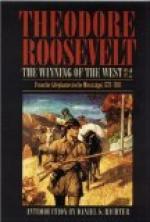Some of the anecdotes they relate are not far removed from the Chinese-like tale—given, if my memory is correct, in Herodotus—of the Athenian soldier, who went into action with a small grapnel or anchor attached by a chain to his waist, that he might tether himself out to resist the shock of the charging foe. A flagrant example is the story which describes how the white man sees an Indian very far off making insulting gestures; how he forthwith loads his rifle with two bullets—which the narrator evidently thinks will go twice as far and twice as straight as one,—and, taking careful aim, slays his enemy. Like other similar anecdotes, this is told of a good many different frontier heroes; the historian usually showing a delightful lack of knowledge of what is and what is not possible in hunting, tracking, and fighting. However, the utter ignorance of even the elementary principles of rifle-shooting may not have been absolutely confined to the historians. Any one accustomed to old hunters knows that their theories concerning their own weapons are often rather startling. A year ago last fall I was hunting some miles below my ranch (on the Little Missouri) to lay in the winter stock of meat, and was encamped for a week with an old hunter. We both had 45-75 Winchester rifles; and I was much amused at his insisting that his gun “shot level” up to two hundred yards—a distance at which the ball really drops considerably over a foot. Yet he killed a good deal of game; so he must either in practice have disregarded his theories, or else he must have always overestimated the distances at which he fired.
The old writers of the simpler sort not only delighted in impossible feats with the rifle, but in equally impossible deeds of strength, tracking and the like; and they were very fond of attributing all the wonderful feats of which they had heard to a single favorite hero, not to speak of composing speeches for him.
It seems—though it ought not to be—necessary to point out to some recent collectors of backwoods anecdotes, the very obvious truths: that with the best intentions in the world the average backwoodsman often has difficulty in describing a confused chain of events exactly as they took place; that when the events are described after a long lapse of years many errors are apt to creep in; and that when they are reported from tradition it is the rarest thing imaginable for the report to be correct.




